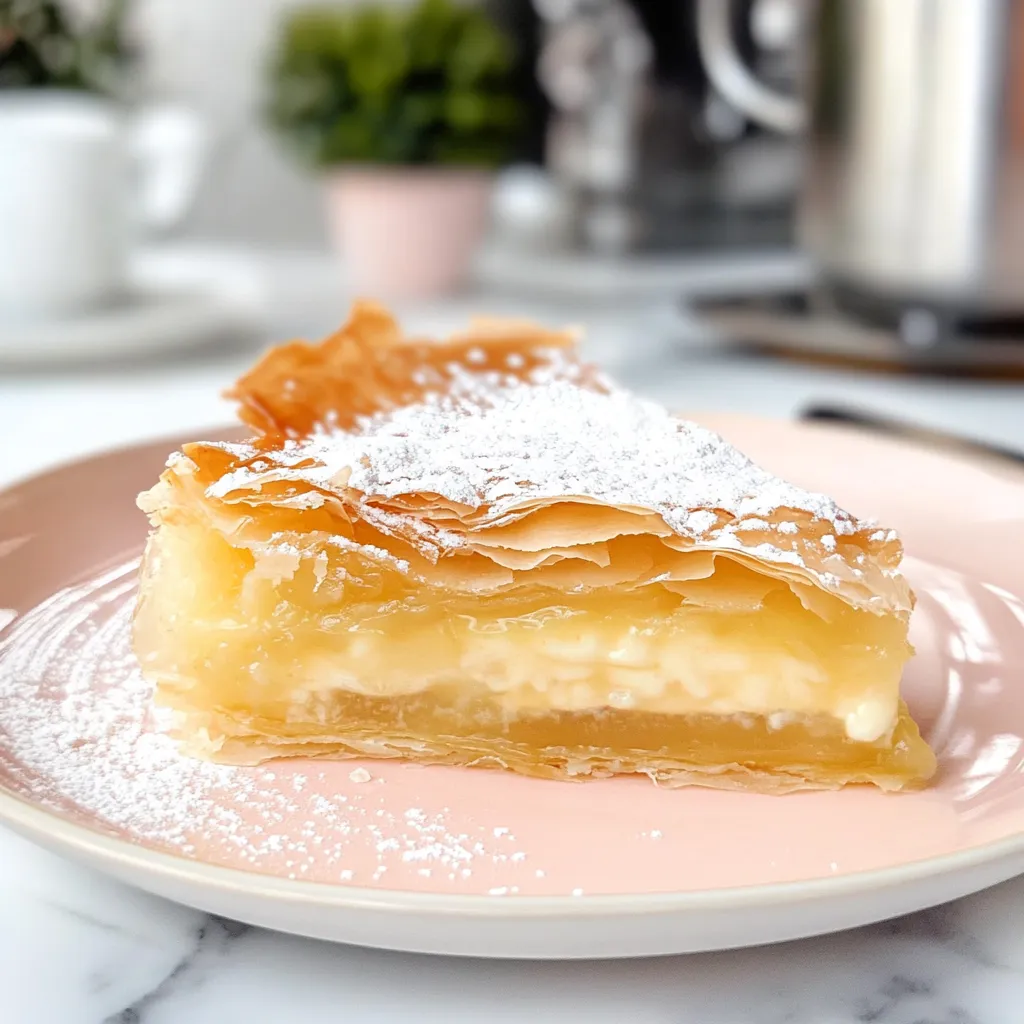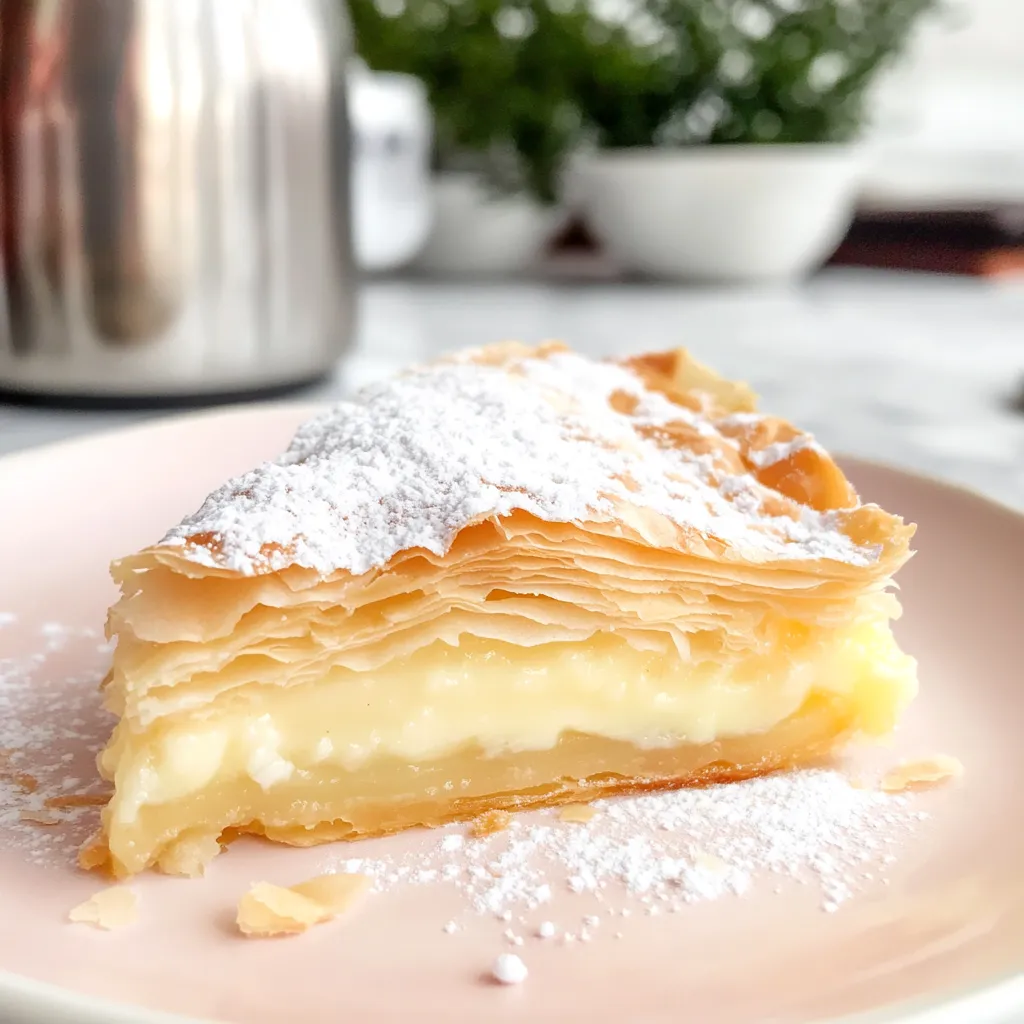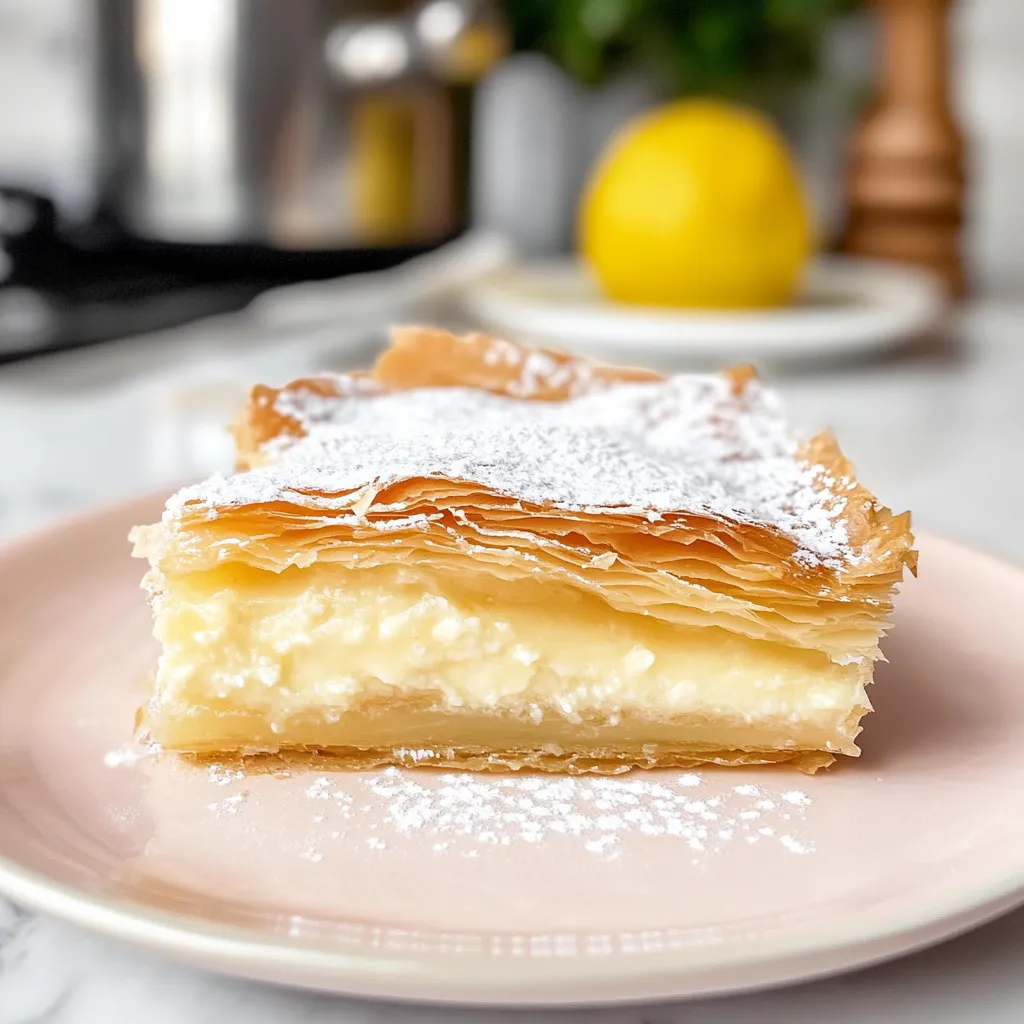 Pin it
Pin it
Bougatsa combines paper-thin filo sheets with velvety smooth custard creating a delightful contrast between flaky, buttery layers and creamy sweet filling. This traditional Greek pastry gets finished with a generous dusting of powdered sugar and warming cinnamon, providing the perfect balance of textures and flavors in every bite. While bougatsa requires some patience to assemble, store-bought filo dough makes this recipe accessible to home cooks looking to create an authentic Greek culinary experience without specialized ingredients or techniques.
I first fell in love with bougatsa during childhood visits to Greektown where my family would seek out this special treat. The anticipation of that first bite – breaking through delicate, crisp layers to reach the warm custard center – created food memories I've carried for decades. When traveling through Greece years later, I made it my mission to try bougatsa from different bakeries, discovering subtle regional variations that all shared the same comforting essence. What surprised me most was learning how approachable this seemingly complex pastry is to make at home – the rustic preparation actually contributes to its charm, requiring no fussy techniques or precision folding to achieve wonderful results.
Essential Elements
- Filo dough: Creates signature paper-thin, crispy layers that shatter delicately when bitten. Store-bought varieties work perfectly saving considerable time and effort.
- Semolina: Forms custard base with distinctive texture and subtle flavor. Fine semolina creates silkiest results though coarser varieties work with slightly different texture.
- Fresh milk: Provides creamy foundation for custard filling. Whole milk delivers richer results though 2% works acceptably with slight compromise in richness.
- Butter: Appears throughout both filling and assembly creating rich flavor and crisp texture. Generous brushing between filo layers ensures proper browning and flakiness.
- Powdered sugar: Creates traditional sweet finishing touch across pastry surface. The fine texture dissolves slightly into warm pastry creating light glaze effect.
- Ground cinnamon: Adds warming aromatic notes that complement custard's sweetness perfectly. Even light dusting adds significant aromatic component to final presentation.
Creation Method
- Prepare silky custard:
- Whisk eggs until well blended creating proper base for custard. Combine butter and sugar in saucepan allowing butter to melt completely before adding milk and semolina. Add vanilla enhancing custard's aromatic profile. Temper eggs with warm milk mixture preventing curdling while incorporating. Cook mixture gently until properly thickened creating ideal custard consistency.
- Allow proper cooling:
- Let custard mixture cool slightly before assembly preventing premature cooking of filo layers. This critical step ensures custard maintains proper consistency while allowing safer handling during assembly process.
- Layer filo strategically:
- Brush baking dish generously with melted butter preventing sticking. Layer filo sheets individually with butter between each layer creating foundation for proper flakiness. Allow excess filo to hang over pan edges creating enclosure for custard filling. This technique creates containment for filling while developing beautiful layered edges.
- Add filling properly:
- Pour cooled custard into prepared filo base distributing evenly throughout pan. Fold overhanging filo edges over filling creating rustic envelope effect. This simple folding technique creates beautiful texture while containing filling effectively.
- Create crinkled topping:
- Add final filo sheets with intentional scrunching creating textural interest on pastry surface. Brush generously with butter ensuring proper browning and flavor infusion. This rustic technique creates beautiful dimension while maximizing crispy texture throughout surface area.
- Bake until golden:
- Place assembled bougatsa in preheated oven allowing proper color development and complete cooking. Watch for visual cues indicating perfect doneness – golden brown surface with visible layering throughout. The extended baking time ensures complete cooking while developing ideal texture contrast.
- Finish with traditional toppings:
- Allow brief cooling period maintaining structure while enabling comfortable handling. Dust generously with powdered sugar and cinnamon creating signature finish. Serve while still warm experiencing optimal texture and flavor contrast.
 Pin it
Pin it
My first attempt at bougatsa taught me valuable lessons about filo handling. I allowed the sheets to dry out while preparing the custard, creating brittle, unworkable pastry. Now I keep unused filo covered with a damp towel maintaining perfect pliability throughout the process. I've also discovered that allowing the assembled bougatsa to rest briefly before baking helps the layers meld together properly, preventing separation during serving. The most surprising discovery was how well bougatsa reheats – while best fresh from the oven, leftover slices warmed at low temperature regained almost all their original texture, making this an excellent make-ahead option.
Serving Suggestions
Present warm with small cups of strong Greek coffee creating authentic experience. Offer alongside fresh seasonal berries providing bright contrast to rich pastry. Consider serving for brunch with simple scrambled eggs balancing sweet treat with savory component.
Flavor Variations
Add lemon zest to custard creating citrus-infused version popular in certain Greek regions. Incorporate chopped pistachios between layers creating nutty dimension throughout pastry. Consider adding orange blossom water to custard for subtle floral notes reminiscent of Middle Eastern influence.
Storage Solutions
Keep leftover bougatsa refrigerated in airtight container maintaining freshness up to three days. Reheat individual portions in 350°F oven restoring crispy texture effectively. Avoid microwave reheating which compromises filo crispness significantly.
The first time I served homemade bougatsa to Greek friends, I nervously awaited their verdict on this traditional treat. Watching their expressions transform to nostalgic joy with the first bite provided the ultimate validation. What makes bougatsa truly special isn't complex technique but thoughtful preparation – the simple combination of flaky filo and creamy custard creates something greater than the sum of its parts. I've discovered it's perfect for those occasions when you want to create something memorable that still feels authentic – it consistently earns enthusiastic reactions while connecting people to Mediterranean culinary traditions through a truly approachable recipe.
 Pin it
Pin it
Frequently Asked Questions
- → What is semolina and can I substitute it?
- Semolina is a coarse flour made from durum wheat. If you can't find it, you can substitute with fine cornmeal or cream of wheat. The texture might be slightly different but still delicious.
- → Can I make bougatsa ahead of time?
- Yes! While it's best freshly baked, you can prepare the custard a day ahead and refrigerate it. Assemble and bake the bougatsa when ready to serve. Leftover baked bougatsa can be refrigerated and reheated in a 300°F oven for 10-15 minutes.
- → How do I prevent filo dough from drying out?
- Keep the unused filo sheets covered with a clean, slightly damp kitchen towel while you work. Work quickly but carefully, and ensure your melted butter is ready before you start.
- → Can I add other flavors to the custard?
- Absolutely! Try adding lemon or orange zest, a pinch of nutmeg, or even a splash of brandy or cognac to the custard mixture for different flavor variations.
- → How do I know when the custard is thick enough?
- The custard should coat the back of a spoon and if you run your finger through it, the line should remain clear. It will continue to thicken as it cools, so don't overcook it.
- → Can I make mini bougatsa instead of one large pan?
- Yes! You can make individual portions by cutting the filo into smaller squares and using muffin tins. Reduce the baking time to about 20-25 minutes.
